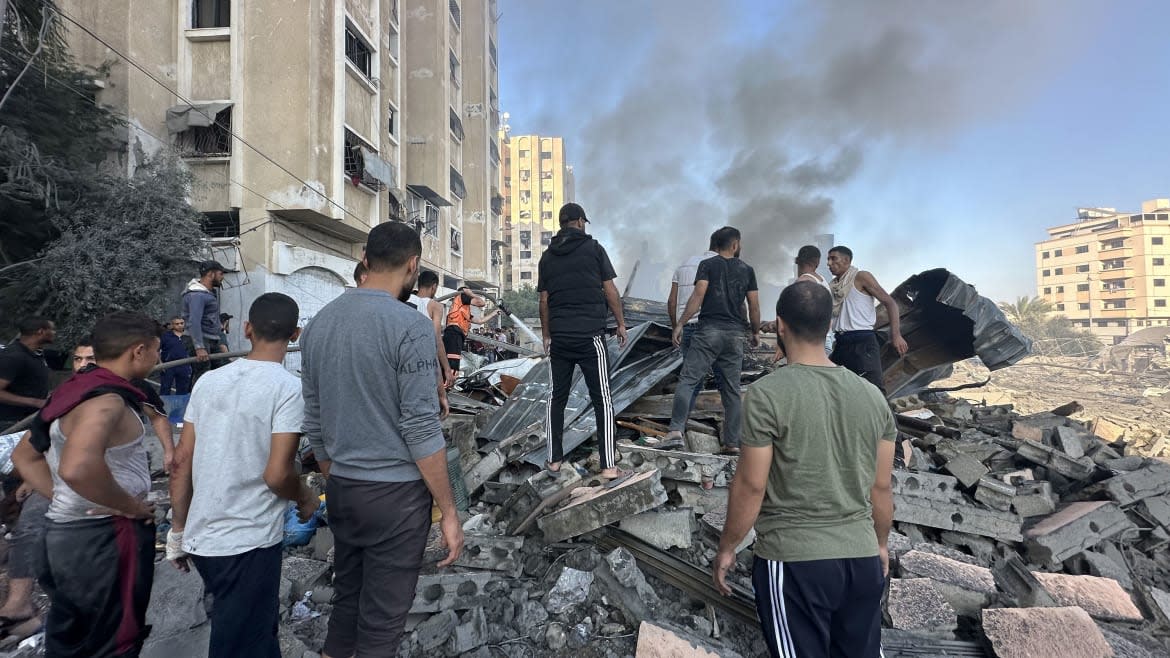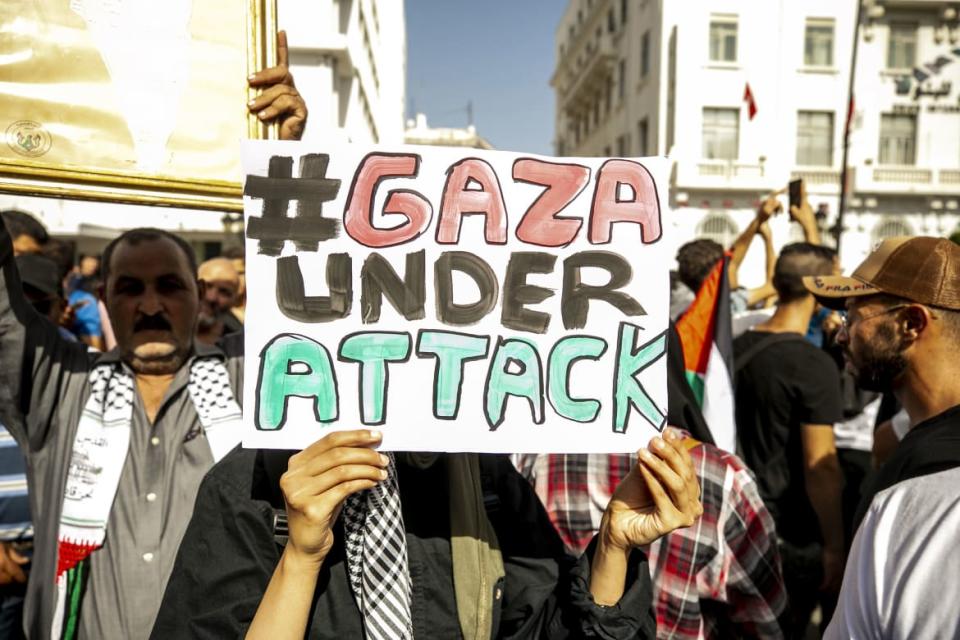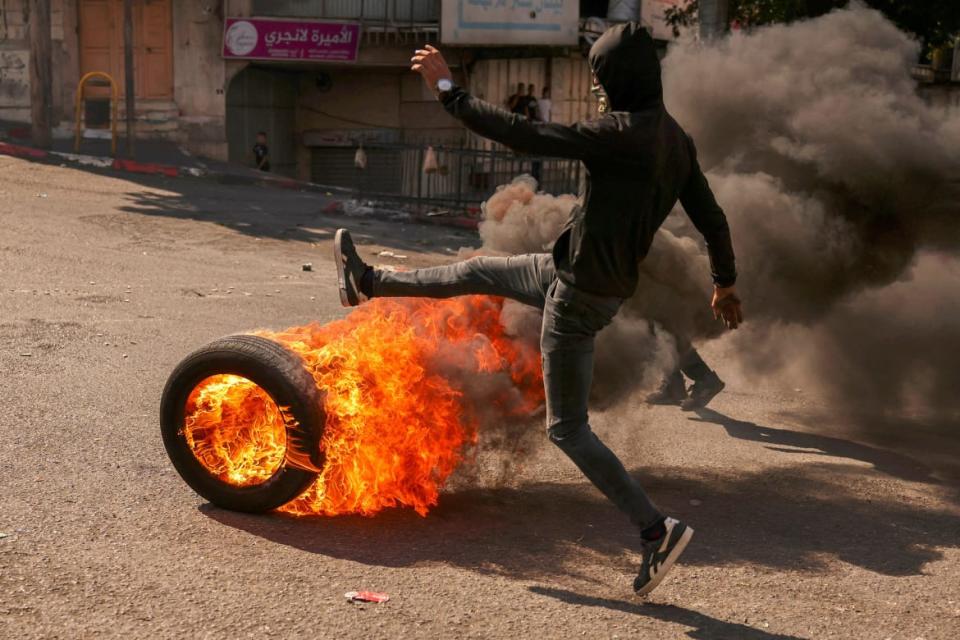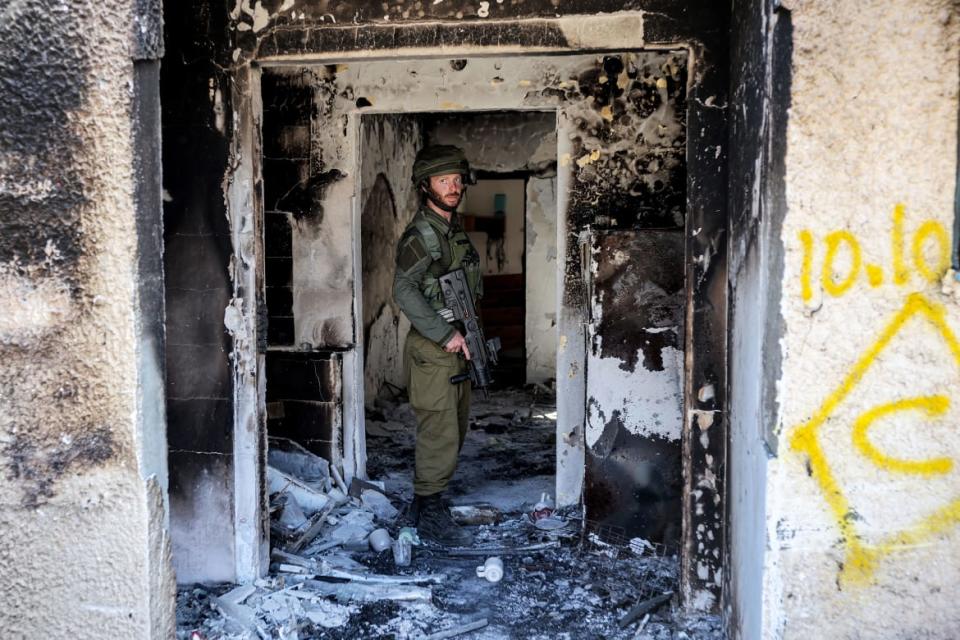Every Option for Israel in Gaza Is Bad

In response to the Oct. 7 Hamas attack in Israel that killed at least 1,400, mostly civilians, and kidnapped about 150 more, the Israeli Defense Forces (IDF) are firing airstrikes into Hamas-controlled Gaza and massing for a ground invasion. But critics fear the worst, and urge otherwise.
“Israel is walking into a trap,” writes Hussein Ibish in The Atlantic, warning that Hamas and its regional supporters want Israel to send forces into Gaza, thinking the mass suffering it inevitably causes will do more harm to Israel’s position than theirs.
Hamas has spent years preparing to fight the IDF, especially in the dense urban environment of Gaza City. They’ve built miles of tunnels, set up booby traps, and prepared ambushes. They told Palestinian civilians not to flee, using the population as human shields. Israeli airstrikes have already killed at least 2,300 Palestinians, many of them civilians, and generated wrenching images of suffering.
Do Hamas’ Brutal Tactics Do Anything to Help Palestinians?
A ground invasion will increase that dramatically. It would give Hamas a chance to fight on their own turf where they can neutralize much of the IDF’s technological advantage, and would counteract sympathy for Israel generated by Hamas’ attack. Many will blame the destruction on Israel, which plays into Hamas and its allies’ efforts to sideline other Palestinian factions, and make armed resistance the only acceptable approach.
Those are all valid worries, and important to consider, but they don’t account for the national security logic now influencing Israel’s actions.
Years of avoiding the Hamas trap led to the deadliest day for Jews since the Holocaust. Reeling from that attack, and willing to pay a price to prevent another, Israel has apparently decided the only way out of the trap is to spring it.
No Good Ideas
In all the laments and warnings about Israel’s pending invasion of Gaza, not one offers a practical alternative.
For example, in The New York Times, Columbia professor Rashid Khalidi highlights decades of Palestinian suffering, including thousands of civilians killed in smaller Israel-Hamas wars, and argues that the death and mass displacement Israel is already causing in Gaza violate international law. His suggested alternative: “the only possible solution is one that ends the oppression of one people by another and guarantees absolutely equal rights and security for both.”
Israelis and Palestinians all living in peace with guaranteed rights and security sounds wonderful, but no one knows how to get there. No matter how desirable a long-term vision, it doesn’t offer recommendations for short-term action—besides, perhaps, stop all military action and leave Hamas in charge of Gaza, free to try again.

Tunisan high school and university students carrying the Palestinian and Tunisian flags gather to protest against Israeli airstrikes in Gaza Strip.
However, the size, complexity, brutality of Hamas’ attack upended a key assessment not only in Israel, but also the United States, Europe, and Arab governments.
For most of the 16 years since Hamas forcibly took over Gaza, they’ve seen the group as a rational actor. Hostile, adversarial, but ultimately doing statecraft—using force selectively to advance specific goals—not terrorism.
When Hamas fired rockets, Israel’s Iron Dome shot most of them down, IDF airstrikes inflicted considerably more damage in response, and Egypt brokered ceasefires. When Hamas kidnapped Israeli soldier Gilad Shalit via tunnel and traded him years later for over 1,000 Palestinian prisoners, Israel thought Hamas was a bad actor, but one they could work with.
As Tablet writer Armin Rosen bluntly put it, the general consensus said “Hamas was strongly ideological but inevitably pragmatic, and cared about retaining its infrastructure and domain in Gaza more than it cared about killing Jews.”
They don’t think that anymore, seeing the group as something worse that must be defeated. Israeli leaders warn of a “long war,” and the IDF says it aims to invade Hamas’ stronghold in Gaza City, and wipe out the group’s military and political hierarchy. If they go through with it, even the best case scenario will be difficult and bloody, especially for Palestinian civilians caught in the crossfire.

A Palestinian demonstrator kicks a flaming tire in Hebron on October 18, 2023.
International Support
Explaining his decision to send U.S. forces to Iraq in 2014, president Barack Obama compared ISIS to the Joker in The Dark Knight, quoting “some men just want to watch the world burn.” The Islamic State had no interest in negotiated coexistence, no rational goal that could be accommodated, and if not stopped by force would keep going until the entire region was aflame.
President Joe Biden apparently now thinks that about Hamas. He called the Oct. 7 attack “an act of sheer evil,” and compared it to “the worst rampages of ISIS,” declaring that “the United States has Israel’s back.” America rushed some military aid, and is talking of sending more.
Secretary of Defense Lloyd Austin urged Israel to follow the laws of war, but that requires steps to reduce civilian casualties, such as warnings to flee before operations commence, not to refrain from fighting a legitimate enemy if they take shelter among civilians. Biden and other top U.S. officials have pushed for safe zones, and more effort to get humanitarian aid to the people of Gaza, but aren’t calling for ceasefires. U.S. diplomats reportedly got a memo instructing them to avoid talking about “de-escalation” or “restoring calm.”
Biden’s Israel Trip Was a Gamble That’s Already Paying Off
American public opinion reflects the terrible lack of good options, but seems to support a ground invasion. An SSRS poll found that 96 percent of Americans feel sympathy for Israelis, 87 percent feel sympathy for Palestinians, and 71 percent say Israel’s military response is fully or partially justified (50 percent fully).
European powers seem to agree, with the leaders of France, Italy, Germany and the U.K. releasing a joint statement with the U.S. German Chancellor Olaf Scholz visited Jordan, Israel, and Egypt, stressing the need for humanitarian aid, but notably not calling for the end of military action.
The Western powers share Israel and multiple Arab states’ perspective that Hamas is part of an Iran-led “Axis of Resistance.” If Israel destroys Hamas, or at least overthrows and weakens the group, it would shift Middle East power politics in the anti-Iran countries’ favor.
The fighting could spark a wider conflagration involving Hezbollah, and possibly a regional war with Iran. Though, as of now, fire across the Lebanese border looks closer to typical Hezbollah-Israel tit-for-tat signaling than preparation for combat.
Don’t Let Politicians Normalize the Dehumanization of Palestinians
Regionally, America and Iran’s actions both look like attempts to deter a wider war, not start one. But as long as the IDF is actively killing people in Gaza, some within the “Axis of Resistance” will feel like they should do something. Forceful signaling could spiral out of control, and the region could ignite, even if the major players don’t want that.
Can Hamas Be Destroyed?
Palestinian opposition to Israel’s occupation will never end, since it derives from the human desire for freedom. And some degree of Palestinian support for armed resistance will remain as long as other means fail to deliver them rights. But defeating Hamas may be doable.
As New York Times columnist David French notes, the military model is the campaign against ISIS in Iraq and Syria, especially the 2016-17 Battle of Mosul, Iraq’s second largest city. Mosul has about 1.68 million people in an area of 69.5 square miles, larger but not as dense as Gaza City, which has about 590,000 in 17.37 square miles. The fight was hard and costly, as over 100,000 U.S.-backed Iraqi military and Kurdish Peshmerga forces took on about 10,000 entrenched ISIS fighters, sometimes block-by-block, building-by-building.
The attacking forces lost about 1,000 soldiers, and killed at least 7,500 ISIS militants. Civilian death estimates range from about 6,000 to over 10,000, with thousands more displaced. But in the end, the anti-ISIS coalition won.
A similar assault on Gaza City could easily be deadlier, since Hamas has had longer to prepare, might have more fighters in a more densely populated area, and civilians have less opportunity to flee. But the IDF is more cohesive and better equipped than the Iraqis. As a military matter, it’s doable (which is not the same as saying Israel will succeed.)
But beyond that, the analogy breaks down.
I’m a Rabbi. Here’s Why I Went to a Murdered Palestinian Boy’s Funeral.
ISIS conquered Mosul from without in 2014, and Iraq began taking it back two years later. Hamas conquered Gaza from within 16 years ago, and was active there 20 years before. It has a base of popular support ISIS never did. There’s nothing else like the Israeli-Palestinian conflict. Hamas gains legitimacy at home and abroad by connection to the Palestinian cause (deservedly or otherwise).
Most importantly, the Battle of Mosul was Iraqis attacking in Iraq, and the Iraqi government took control after. Israelis are attacking in Gaza, and if they manage to remove Hamas, it’s not clear who runs the territory after.
Would it be Israel, in a difficult, indefinite occupation? The Palestinian Authority, which has questionable capacity, and would seem like the IDF’s stooge? Someone else?

An Israeli army soldier stands in a burnt building near the Gaza Strip on October 18, 2023.
All Options Are Bad
For the last 16 years, Israel’s approach to Hamas involved small wars in Gaza every few years to destroy rockets, launchers, and tunnels, a strategy crudely nicknamed “mowing the grass.” They were mostly air exchanges, and typically ended in Egypt-brokered ceasefires. The fights left some Israelis and hundreds, sometimes thousands of Palestinians dead without causing any lasting improvement in the situation. As the lawnmowing metaphor suggests, even the best result meant having to do it again in the near future.
It was always bad, but so is every alternative.
A “total siege” that cut off Gaza’s electricity, fuel, food, and water was collective punishment—immoral, illegal, and strategically counterproductive. Israel rightly eased up (reportedly with American encouragement).
Forced displacement, as Israel is causing by telling people to flee the northern half of Gaza, is really bad. Egypt and Israel aren’t letting people out, so the only place to go is the southern half of Gaza, which Israel is also bombing (though not as much), and lacks the resources to absorb them.
A ground invasion of Gaza City without first warning people to leave would be even worse.
Giving in to Hamas’ human shields strategy, as if they can slaughter innocents and escape consequences by putting more innocents at risk, would be really bad. From a national security perspective, that’s intolerable.
The remaining option is a campaign to end Hamas, at considerable military and humanitarian cost, with a risk of a wider war. And half-measures or failure might be the worst possibility of all, harming a lot of people without achieving security goals.
Israel’s War Isn’t Against Hamas—It’s on the Palestinian People
Peace in the Middle East
As David Ignatius highlights in The Washington Post, advancements in Arab-Israeli peace have followed the upheavals of war. The 1967 Six Day War and 1973 Yom Kippur War set up the 1979 Camp David Accords and a peace between frequent combatants Egypt and Israel that’s into its fifth decade. The 1993 Israeli-Palestinian Oslo Accords and the 1994 Israel-Jordan peace treaty followed the First Intifada.
The coming weeks will likely be very violent, with most of the suffering falling on the people of Gaza, who’ve been getting screwed from all directions for a long time.
But there’s a chance that, when the fighting stops, Israeli-Palestinian peace can move forward without some of its biggest obstacles.
Get the Daily Beast's biggest scoops and scandals delivered right to your inbox. Sign up now.
Stay informed and gain unlimited access to the Daily Beast's unmatched reporting. Subscribe now.

